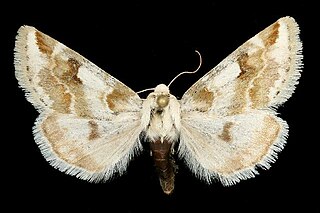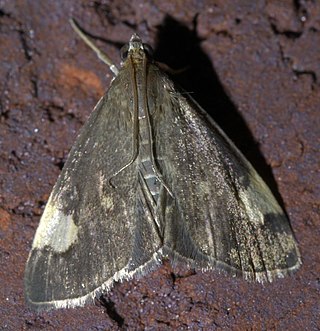
The flame shoulder is a moth of the family Noctuidae. The species was first described by Carl Linnaeus in 1761. It is distributed throughout the Palearctic from Ireland in the west to Siberia then Korea and Japan in the east.
Bipectilus is a genus of moths of the family Hepialidae. There are eight described species in the genus, distributed through China, Nepal and Vietnam.

The Fucales (fucoids) are an order in the brown algae. The list of families in the Fucales, as well as additional taxonomic information on algae, is publicly accessible at Algaebase.

Schinia, commonly called flower moths, is a large genus of moths belonging to the family Noctuidae. The genus has a Holarctic distribution with the vast majority of species being found in North America, many with a very restricted range and larval food plant.
Phaio is a genus of moths in the subfamily Arctiinae.

The rabbitbush flower moth is a moth of the family Noctuidae. It is found from central Arizona and New Mexico, north to Colorado, south-western Wyoming and Utah, west to Nevada and California, and north to Oregon, Idaho and Washington.
Phaio acquiguttata is a moth of the subfamily Arctiinae. It was described by Paul Dognin in 1909. It is found in Colombia.
Phaio albicincta is a moth of the subfamily Arctiinae. It was described by Schaus in 1896. It is found in Ecuador.
Phaio aurata is a moth of the subfamily Arctiinae. It was described by Schaus in 1892. It is found in Peru.
Phaio bacchans is a moth of the subfamily Arctiinae. It was described by Schaus in 1892. It is found in Peru.
Phaio caeruleonigra is a moth of the subfamily Arctiinae. It was described by Schaus in 1905. It is found in Peru.
Phaio cephalena is a moth of the subfamily Arctiinae. It was described by Druce in 1883. It is found in Colombia and Ecuador.
Phaio geminiguttata is a moth of the subfamily Arctiinae. It was described by Paul Dognin in 1911. It is found in Colombia.
Phaio longipennis is a moth of the subfamily Arctiinae. It was described by Berthold Neumoegen in 1894. It is found on Cuba. The specific name was spelled "longipenuis" in the original 1894 description, and emended to "longipennis" in 1898; under ICZN Article 33.2.3.1 the emended spelling is to be preserved.
Phaio quadriguttata is a moth of the subfamily Arctiinae. It was described by Paul Dognin in 1909. It is found in Ecuador.
Phaio salmoni is a moth of the subfamily Arctiinae. It was described by Herbert Druce in 1883. It is found in Colombia.
Phaio stratiotes is a moth of the subfamily Arctiinae. It was described by Harrison Gray Dyar Jr. in 1914. It is found in Panama.
Phaio sylva is a moth of the subfamily Arctiinae. It was described by Schaus in 1896. It is found in Brazil.
Pseudaclytia unimacula is a moth in the subfamily Arctiinae. It was described by Schaus in 1905. It is found in French Guiana.

Evergestis unimacula, the large-spotted evergestis moth, is a moth in the family Crambidae. It was described by Augustus Radcliffe Grote and Coleman Townsend Robinson in 1867. It is found in North America, where it has been recorded from Georgia, Illinois, Indiana, Iowa, Maryland, Michigan, North Carolina, Ohio, Oklahoma, Ontario, Pennsylvania, Quebec, Tennessee and West Virginia. Outliers have been recorded from Florida.




